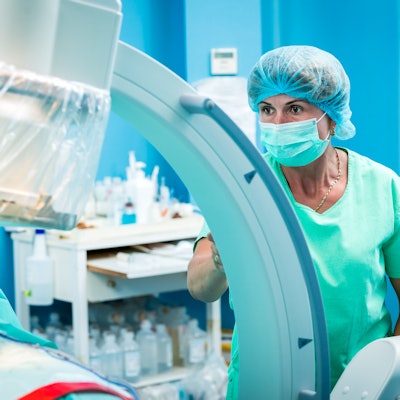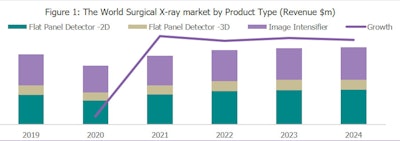
The world market for interventional and surgical x-ray equipment is forecast to reach almost $3.9 billion by 2024, according to a new report from Signify Research. The world markets for interventional x-ray and surgical x-ray are estimated to have declined by 17.4% and 16.3%, respectively, in 2020.
Growth in this market is predicted to return from 2021 onward as the negative impact of the pandemic is expected to subside. Recovery is forecast to be gradual rather than V-shaped, with the steady return of elective procedures and as healthcare expenditure is restored following the diversion to COVID-related equipment.
Product trends
In the surgical x-ray market, flat-panel detector (FPD) 2D mobile C-arms are forecast to have the fastest growth through to 2024, with a compound annual growth rate (CAGR) of 3.4%. In 2020, there was a shift toward low-end to midrange FPD 2D systems as a result of stretched capital expenditure budgets.
Demand for image intensifier-based C-arms is slowing down, with emerging regions now key markets. However, in developed markets, such as the U.S., usage of imaging intensifier systems is still high in pain management clinics.
3D mobile C-arms are primarily used for imaging the joints, spinal fusion, and fractures, and the market is expected to start seeing signs of recovery from 2021 onward, following the return of elective spinal procedures to prepandemic levels. Countries with the highest adoption of 3D surgical x-ray imaging include China, Western Europe, and the U.S.

Within the interventional x-ray market, the interventional cardiology (IC) market was more negatively impacted by COVID-19 than interventional radiology (IR) due to heavier reliance on elective procedures. An increase in the number of structural heart procedures performed, in particular percutaneous coronary intervention (PCI), continues to be a factor maintaining clinical demand for the IC market.
The interventional radiology market has experienced a continued expansion of clinical procedures being performed. An increased incidence of peripheral vascular disease is driving demand for general vascular angiography. Despite an estimated 26% drop in the hybrid operating room segment in 2020, the fastest growth is predicted for this product category through to 2024.

The key regional trends include the following:
- North America: The North American market has been significantly impacted due to postponement of noncritical surgeries, and as budgets for nondiagnostic x-ray equipment were diverted to COVID response. The North American market will be driven by replacements of existing equipment and increasing demand from outpatient clinics and facilities.
- Latin America: Brazil has been one of the worst impacted countries globally by COVID-19, resulting in a severe market retraction for both the interventional and surgical x-ray markets in 2020.
- Western Europe: The Western Europe market is forecast to experience pricing pressures from 2020 onwards, with the economy suffering as a result of high COVID-19 impact. Recovery is expected to be steady and gradual through to 2024 as economies struggle with the impact of the pandemic.
- Eastern Europe, Middle East, and Africa: The Saudi Arabia-Russia oil price war and the COVID-19 pandemic have further set back the prospects of a recovery and the market is forecast to sharply decline in 2020 by 20.1%. Postponement of elective procedures contributed to the huge drop in demand in 2020.
- Asia Pacific: The Chinese market has had one of the quickest recoveries from the COVID-19 pandemic globally, with a forecast contraction of high single digits in 2020 for the surgical x-ray market. Demand for hybrid operating rooms and 3D mobile C-arms is high in China, mainly in high-end hospitals.
COVID-19's clinical impact
From 2021 onwards, there is expected to be pent-up demand for both interventional and surgical x-ray systems. With the postponement of nonessential elective surgeries and medical procedures to conserve medical resources for COVID-19 patients, cardiovascular procedures were severely impacted during 2020. However, the massive financial burden of COVID-19 on healthcare providers is expected to result in reduced capital expenditure budgets for imaging equipment, including interventional x-ray and mobile C-arm systems.
While PCI procedures are assumed to be critical in treating acute myocardial infarctions (MI), only a small number of PCI procedures performed on patients were for these life-threatening conditions. The rest of the PCI procedures are considered "elective procedures" and were deferred during the pandemic. Globally, hospitals saw a decline in cardiovascular procedures.
The pandemic is having a negative impact across all interventional markets (including IC and IR), due to a combination of reduced vendor sales activity (on-site demonstrations, new product launches, conferences) and plummeting elective procedure volumes during national lockdowns.
Demand for image intensifier mobile C-arms was less impacted than for FPD equivalents in 2020 due to COVID-19, as providers focused on cost-effective equipment due to reduced capital budgets.
Bhvita Jani is a senior marketing analyst at Signify Research.
The comments and observations expressed are those of the author and do not necessarily reflect the opinions of AuntMinnie.com.
Copyright 2020 © Signify Research



















